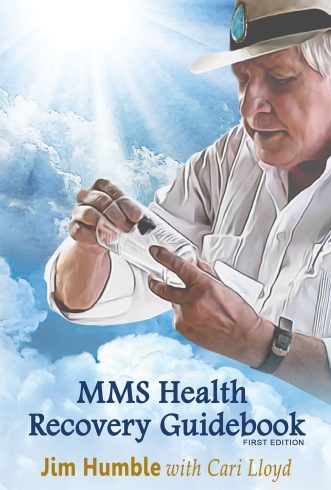- Posts: 1
- Thank you received: 0
 How does MMS distinguish between good and bad bacteria?
How does MMS distinguish between good and bad bacteria?
- MikeF
-
Topic Author
- Offline
- New Member
-

I have been using MMS1 (3 activated drops per capsule 2x weekly) as a maintenance dose for the past 18 months. I have found it very helpful for clearing up the minor aches and pains that I had. Strangely, my bladder capacity seems to have increased, meaning that now I don't need to get up in the night. The capsules totally avoid the bad MMS taste.
I have also used the spray and bath protocols.
My question:
My understanding is that chlorine dioxide is highly selective; targeting only pathogens while not affecting healthy body cells.
But how exactly does MMS distinguish between beneficial gut bacteria, and harmful pathogens in the body? Or does MMS simply destroy all bacteria?
I have read Jims book - Master Mineral Solution of the Third Millenium, but this point is not clear to me.
I take probiotics regularly - maybe this replaces the good bacteria killed by MMS?
Thanks for all your good work.
Mike
Please Log in or Create an account to join the conversation.
- marti
-
- Offline
- Elite Member
-

- Posts: 252
- Thank you received: 63
This interested me too, but if you think about it himself, MMS kills any bacteria......
Please Log in or Create an account to join the conversation.
- CLO2
-

- Offline
- Administrator
-

If MMS killed all bacteria we would be hearing complaints about that happening, but we don't.
Think about that....
Please Log in or Create an account to join the conversation.
- pneumatician
-

- Offline
- Premium Member
-

MikeF wrote: Good day to All
My question:
My understanding is that chlorine dioxide is highly selective; targeting only pathogens while not affecting healthy body cells.
But how exactly does MMS distinguish between beneficial gut bacteria, and harmful pathogens in the body? Or does MMS simply destroy all bacteria?
I have read Jims book - Master Mineral Solution of the Third Millenium, but this point is not clear to me.
I take probiotics regularly - maybe this replaces the good bacteria killed by MMS?
Mike
you need to make in-vitro and in-vivo tests
in-vitro, grow a colony bacteria in a petri dish and test with MMS, if the bacteria die, ok, if not, bad.
this is a procedure from the pseudoscience called "biomakealotofmoneyfornothing"
the antibiotics simply KILL EVERYTHING till no more ammo.
exist millions if not billions of different microorganism called virus, bacteria, fungus, amoebas... this is a herculean work. I don't known if MMS people have a good lab and are doing this type of test. If you are interested in some type of microorganism specifically, depending where you live you can do this test for yourself in a community lab.
but the bad news is: virus, parasites... are everywhere, inclusive in incredible things like alcohol. parasites eating your brain, eating... a terror film!! so always the best is a strong immune system!!
probiotics is a good choice after a batch of antibiotics.
~~~
llucifer.in
Please Log in or Create an account to join the conversation.
- Ryan77
-
- Offline
- New Member
-

- Posts: 13
- Thank you received: 2
Please Log in or Create an account to join the conversation.
- Dawna
-
- Offline
- Platinum Member
-

- Posts: 446
- Thank you received: 342
Because animal cells do not have cell "walls", as do microorganisms, human tissue is not affected by the same action. For this reason, chlorine dioxide is safe for use in drinking water as well as for application to the skin.
Of importance as well, the use of chlorine dioxide does not result in the creation of resistant strains of microorganisms, such as occur with other disinfectants like Triclosan, (which is in toothpaste)
Chlorine dioxide eliminates or neutralizes odor by a process known as oxidation. It is not a masking agent. The same oxidizing properties result in a bleaching or whitening action.
Above is from FrontierPharm.com where Dioxi Brite toothpaste is sold
Yes, it works!
Please Log in or Create an account to join the conversation.
- Drummerchuck
-
- Offline
- New Member
-

- Posts: 19
- Thank you received: 28
From the more recent thread:
I had to dive deeper into biology to wrap my own head around this. You'll read in the books/wikis/forums about how ClO2 is a weak oxidizer, it has a ORP [oxidation reduction potential] of 0.98 volts, roughly. Compare that to Oxygen at 1.28 volts. So what it comes into contact with in our bloodstream and digestive tracks are only going to be oxidized if they have ORP voltage levels where that is possible. The "bad guys" bacteria are mostly at or about -200 mV, or -.2 volts, so they are oxidized easily while our "good guys" bacteria are closer to 1 volt. In other words, ClO2 passes right by those good guys just like oxygen does, since they are similar in their oxidative potentials. I'm sure this is a bit more complicated than just my simplistic explanation here, but it's where I'm at presently and it fits in line with the results from the research [of no measurable harm or ill physiological effects from ClO2 ingestion at protocol levels].
Please Log in or Create an account to join the conversation.
- Dawna
-
- Offline
- Platinum Member
-

- Posts: 446
- Thank you received: 342
Good bacteria has an oxygen molecule, MMS has an oxygen molecule.
Bad bacteria lacks a oxygen molecule.
MMS seeks all molecules without oxygen, it gives them a hug to save them, but the oxygen kills it.
Please Log in or Create an account to join the conversation.

